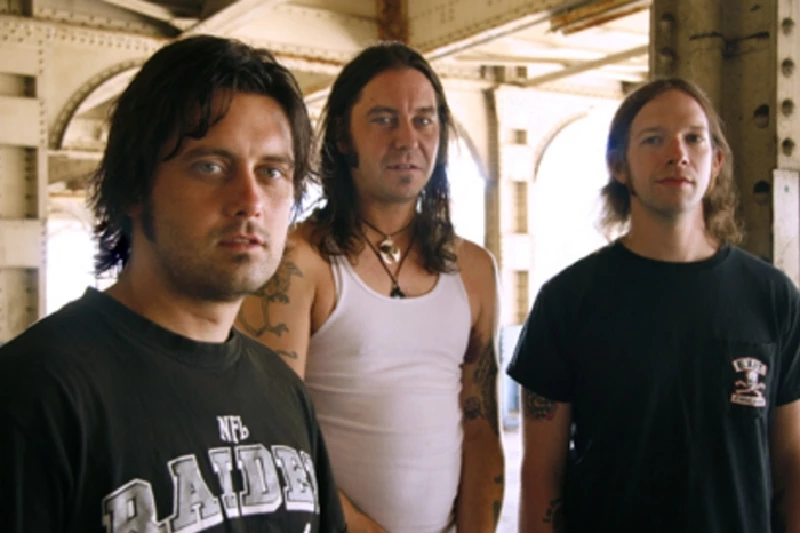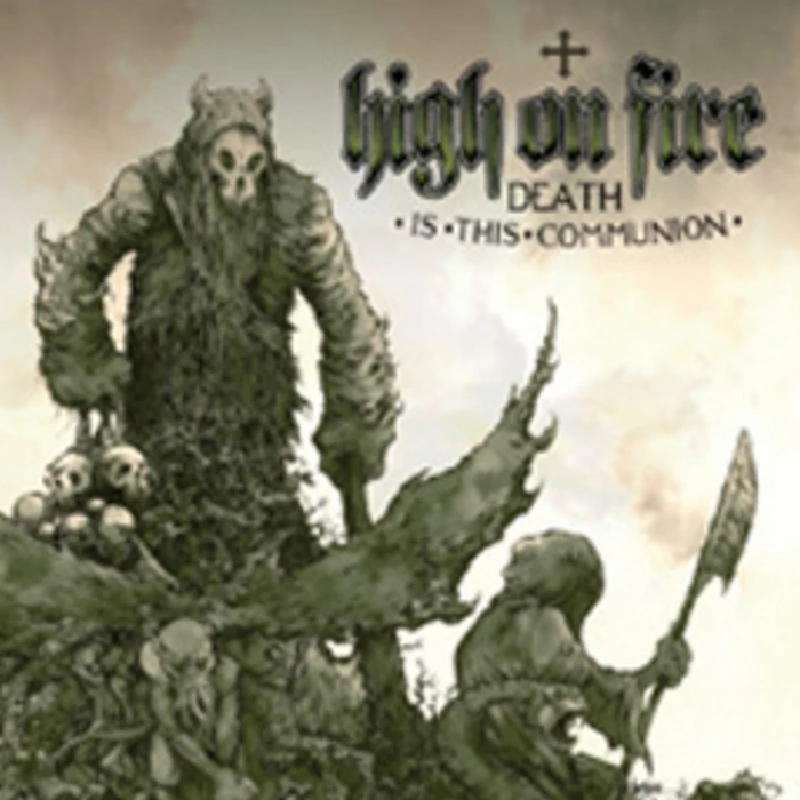High On Fire - Profile
by Andrew Carver
published: 23 / 11 / 2007

intro
Andrew Carver contemplates the career of Californian doom metal titans High on Fire who have just released their fourth album, 'Death is This Communion'
California doom metal titans High on Fire occupy an august place in the world of doom metal – not only the heirs to the throne one occupied by the band’s predecessor Sleep, but also one of the few acts in the metal universe whose popularity reaches beyond its long-haired denizens. It is a reputation ready to grow even further in the wake of the release of their fourth album, ‘Death Is This Communion’ The musical path that leads to High on Fire (and other acts in the Sleep fold like Kalas, Operator Genererator, the Sabines and Om) starts with the little-known quartet Asbestosdeath. Obscure even to some Sleep fans, Asbestosdeath deserves to be called, Sleep Mk. I. It featured the core of Sleep, bassist Al Cisneros, guitarist Matt Pike and drummer Chris Hakius along with Thomas Choi, and three of the four songs it released in its lifetime were reworked and rerecorded by Sleep. The two 7-inches released under the Asbestosdeath name blend hardcore punk and 1980s doom metal acts like St. Vitus and the Obsessed. After the demise of Asbestosdeath, Pike, Cisneros and Hakius recruited Justin Marler and formed Sleep. Thomas Choi went on to an earlier incarnation of sludge dealers Noothgrush, ItIsI and Operator Generator, which released a decent space-metal offering ‘Polar Fleet’ on Man’s Ruin in 2001. The appropriately titled 'Volume I', released in 1991 by the Very Small label, kicks off with the monastic chanting of 'Stillborn', segues into some call-and-response guitar between Marler and Pike. The reworked ‘The Suffering’ lurches between rhythm section stomp and brief bursts of furious guitar. The brutal downer lyrics of ‘Numb’ and the aggressive bark of the vocals take a few cues from hardcore. ‘Catatonic’ may be the most interesting track: Is that a Middle Eastern musical motif peaking out from the intro ? The title of ‘Nebuchadnezzar’s Dream’ also shows the band looking east. As hard-hitting as much of ‘Volume I’ is, it’s also sometimes unfocussed. At its best, doom metal should seem relentless, however molasses-slow it gets. Too often the songs of ‘Volume I’ lose their train of thought. The speedy intro of ‘Wall of Yawn seems more adroit, with the vocals blending better with the riffage than most of the other songs. Following the release of ‘Volume I’, Marler left the band and joined a Russian Orthodox monastery. The reduction to a three piece seemed to reinvigorate the remaining trio, and signed to Earache the band released ‘Holy Mountain’, the album that cemented their (un)holy trinity of eastern mysticism, Black Sabbath and bong-loads of pot. The opening riff to ‘Dragonaut’ is pure Sabs. There’s a newfound melodicism in Al Cisneros’ slightly tremelo-laden voice. The piecing leads of ‘Druid/Solomon’s Theme’ are even more unhinged than Tony Iommi’s finest. There’s also variety, with the bluesy slide of the brief ‘Some Grass’ sounding like a Bassholes outtake. The album’s centrepiece is the one-two punch of ‘Aquarian’ and the title track. Their pummelling groove packs an unstoppable crunch that almost makes the rest of the album almost seem like an afterthought. ‘Inside The Sun’ seems like a bit of a throwback to ‘Volume I’ with its naked vocals and slightly rougher production, but as soon as the ‘singing’ drops away the band returns to firmer ground with Cisneros unleashing a punishing bass solo. The lockstep vocals of ‘From Beyond’, rooted in the chants and incantations of the monastery, carved out another bit of the mold from which the final Sleep opus would be made. With ‘Holy Mountain’ under their belt, the band conceived a mad scheme – why not record an album featuring just one, really long song? Unfortunately, what should have been the ultimate statement of doom rock never came out when it should have. Problems with their record label of the time, London, left what was to have been their third album in the can and augured the breakup of the band. Fortunately, the legend of Sleep’s ultimate musical statement lived on, and about the same time that Pike returned to rock with High on Fire in 1999, the Music Cartel label released ‘Jerusalem’. A 52-minute song split into six parts, ‘Jerusalem’ charted the journey of a pot-smoking pilgrim, ‘The Weedian’ on his journey to the Holy Land with a combination of lumbering riffs and stoned pseudo-prophecy. The following year, Man’s Ruin released High on Fire’s first album, ‘The Art of Self Defense’. Once again Black Sabbath, Christian mysticism and pot played an outsized role in the group’s musical and lyrical focus, with a bit of kung-fu flick fandom thrown in. The pace, however, picked up considerably with Pike at the forefront as sole guitarist and vocalist. Pike’s axe still sounds like a chainsaw being revved up, but things have been taking to a higher gear. The album’s first song ‘Baghdad’ immediately showcases greater speed and Pike’s barked vocals (highly reminiscent of Motorhead frontman Lemmy’s) shoves things along as well. Drummer Des Kensel keeps up a steady rumble that keeps the tunes from heading into either thrash territory or torpid doom. The follow-up album on Relapse, ‘Surrounded by Thieves’, charts an even more relentless pace. The album begins with a distant rumble that probably led a few folks to turn up the volume before the album kicks in with ‘Eyes and Teeth’. The production by Billy Anderson (Melvins, Neurosis, Eyehategod, Swans and, of course, Sleep) gives Des Kensel’s drums a sharp crunch and Pike’s guitar playing an elephantine heft. Des Kensel marches his way into ‘Hung, Drawn and Quartered’ with some battlefield-ready drumming that matches Pike’s hoarse-throated calls to “burn down the pillars of time” and crush evil. The Conan the Barbarian meets Old Testament lyrics surface throughout the album, barring a paean to the Yeti which draws on UFO movement mythology to paint the Abominable Snowman as a spacecraft-hopping seer over a steady loping riff. Thanks to its lyrical consistency and punishing tones the album is widely regarded as the band’s highpoint. The following year, Sleep’s ‘Jerusalem’ returned in a re-mastered and band-approved edition as ‘Dopesmoker.’ A far superior work to ‘Jerusalem’, the album’s title track is re-imagined as a single 63-minute long opus, with Billy Anderson producing again. The closest competitor to ‘Surrounded by Thieves’ is its successor, ‘Blessed Black Wings’. The 2005 album also ushered in Joe Preston, a bassist whose resume included Sunn 0))), Melvins, Thrones and Earth. He fit seamlessly into High on Fire’s formula, while new engineer Steve Albini brought a slightly crisper sound to the production. Starting with the howling fury of ‘Devilution’, the band sticks dogmatically to the winning formula of ‘Surrounded’, rewarding the listener with more tooth-gnashing vocals and shredding guitars, at least until the final instrumental track, ‘Sons of Thunder’, which has a low key intro. While Pike was busying himself with High on Fire, his compatriots from Sleep, bassist Al Cisneros and drummer Chris Haikus were reconvening as Om. Starting with ‘Variations on a Theme’ from 2005, the duo has produced three albums. On ‘Variations’, released on the stoner psych label Holy Mountain, Cisneros and Haikus continue with the methodical drone of Sleep’s ‘Dopesmoker’. With only bass to provide the riffs and Haikus’ steady, unfussy drumming, the album’s three tracks produce a mammoth drone for Cisneros’ sonorous philosophical mantras to float over. Unlike High on Fire, Om adheres to Sleep’s marathon track times, with opener ‘On the Mountain at Dawn’ clocking more than 21 minutes long and its two brethren almost reaching the 12-minute mark. Refining the formula over time, the band’s latest ‘Pilgrimage’ landed only a few weeks after High on Fire’s ‘Death Is This Communion’. Its four tracks – two of which last a mere five minutes (shocking!) show the band inching toward Pink Floyd circa ‘Set Your Controls for the Heart of the Sun’. As for High on Fire, for their latest release, the band once again switched producers, to Jack Endino, a producer best known for his work with almost every Seattle band worth naming in the 1990's, including Nirvana, Mudhoney, Green River, Screaming Trees, as well as more relevant recent work for stoner rock titans Nebula and The Atomic Bitchwax. That may explain why the guitar noise that stomps out of the speaker when the band lashes out with ‘Fury Whip’ has some of Screaming Trees’ creamy tone. No one will, however, confuse Pike’s grimacing growl for Mark Lanegan’s husky sound. On subsequent tracks, the band largely sticks to the niche it carved out in the metal sphere: Huge Sabbath riffs, mammoth Motorheading bass, courtesy of Jeff Matz and Pike’s hoarse, Lemmyesque vocals (his skittering lead work is mostly an afterthought). Elsewhere, the influence of classic metal bands like Venom rear their head in thrashing numbers like ‘Turk’ and the death and doom littered through the lyrics (fans of Celtic Frost will also note the orchestral outro to ‘Dii’). There are a few extra sonic flourishes, like the jangling guitars that peep out from the rhythmic thunder of the pun-titled ‘Waste of Tiamat’ and add a Middle Eastern flavour to the instrumental ‘Khanrad’s Wall’, but the monstrous rumble that first attracted the head-banging hordes is still the main draw. The lockstep concussion of Des Kensel’s drums and Pike’s guitar may almost assume a seductive sway on songs like ‘Ethereal’, its still in the service of an inexorable tidal wave of sound. The album concludes with ‘Return to Nod’ – a steamrolling ode, perhaps, to Pike’s origins in Sleep.
Picture Gallery:-

most viewed articles
current edition
Peter Doherty - Blackheath Halls, Blackheath and Palace Halls, Watford, 18/3/2025 and 21/3/2025Armory Show - Interview with Richard Jobson
Liz Mitchell - Interview
Deb Googe and Cara Tivey - Interview
Lauren Mayberry - Photoscapes
Max Bianco and the BlueHearts - Troubadour, London, 29/3/2025
Garfunkel and Garfunkel Jr. - Interview
Maarten Schiethart - Vinyl Stories
Clive Langer - Interview
Sukie Smith - Interview
previous editions
Heavenly - P.U.N.K. Girl EPBoomtown Rats - Ten Songs That Made Me Love....
Trudie Myerscough-Harris - Interview
Doris Brendel - Interview
Beautiful South - Ten Songs That Made Me Love...
Pulp - Ten Songs That Made Me Love...
Dwina Gibb - Interview
Kay Russell - Interview with Kay Russell
Barrie Barlow - Interview
Sound - Interview with Bi Marshall Part 1
most viewed reviews
current edition
Davey Woodward - Mumbo in the JumboNigel Stonier - Wolf Notes
Wings - Venus and Mars
Kate Daisy Grant and Nick Pynn - Songs For The Trees
Only Child - Holy Ghosts
Neil Campbell - The Turnaround
Philip Jeays - Victoria
Darkness - Dreams On Toast
Suzanne Vega - Flying With Angels
Charles Ellsworth - Cosmic Cannon Fodder
Pennyblackmusic Regular Contributors
Adrian Janes
Amanda J. Window
Andrew Twambley
Anthony Dhanendran
Benjamin Howarth
Cila Warncke
Daniel Cressey
Darren Aston
Dastardly
Dave Goodwin
Denzil Watson
Dominic B. Simpson
Eoghan Lyng
Fiona Hutchings
Harry Sherriff
Helen Tipping
Jamie Rowland
John Clarkson
Julie Cruickshank
Kimberly Bright
Lisa Torem
Maarten Schiethart